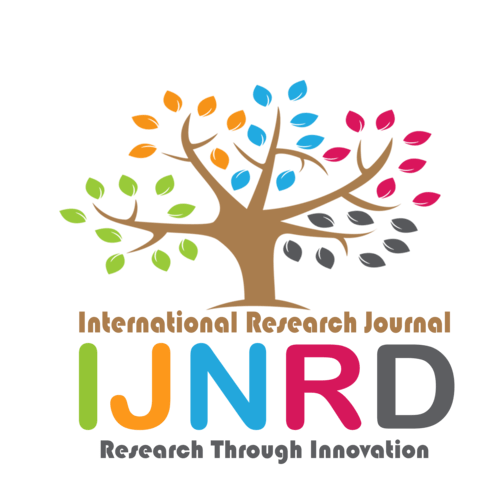|
|||||||||||||||

|
INTERNATIONAL JOURNAL OF NOVEL RESEARCH AND DEVELOPMENT International Peer Reviewed & Refereed Journals, Open Access Journal ISSN Approved Journal No: 2456-4184 | Impact factor: 8.76 | ESTD Year: 2016 Scholarly open access journals, Peer-reviewed, and Refereed Journals, Impact factor 8.76 (Calculate by google scholar and Semantic Scholar | AI-Powered Research Tool) , Multidisciplinary, Monthly, Indexing in all major database & Metadata, Citation Generator, Digital Object Identifier(DOI) |
||||||||||||||
Issue: May 2024
Volume 9 | Issue 5
Review Result and Publication of Paper within : 2-3 days
Click Here For more DetailsFor Authors
Forms / Download
Published Issue Details
Editorial Board
Other IMP Links
Facts & Figure
Impact Factor : 8.76
Issue per Year : 12
Volume Published : 9
Issue Published : 96
Article Submitted :
Article Published :
Total Authors :
Total Reviewer :
Total Countries :
Indexing Partner
Join RMS/Earn 300
Licence
This work is licensed under a Creative Commons Attribution-NonCommercial 4.0 International License







|
Published Paper Details
|
|
| Paper Title: | MELATONIN: A NEW HORIZON FOR DIABETIC PATIENTS |
| Authors Name: | Anuska Dutta |
| Download E-Certificate: | Download |
| Author Reg. ID: |
IJNRD_209403
|
| Published Paper Id: | IJNRD2311252 |
| Published In: | Volume 8 Issue 11, November-2023 |
| DOI: | |
| Abstract: | The global prevalence of Diabetes Mellitus (DM) is increasing in leaps and bounds. The international diabetes federation (IDF) has estimated 592 million people will suffer from DM by 2035. Hence, finding a novel bio molecule that can effectively aid diabetes management is vital, as other existing drugs have numerous side effects. Melatonin, a pineal hormone having anti-oxidative and anti-inflammatory properties, has been implicated in circadian dysrhythmia-linked DM. Reduced levels of melatonin and a functional link between melatonin and insulin are implicated in the pathogenesis of type 2 diabetes mellitus (T2DM). Additionally, genomic studies revealed that rare variants in melatonin receptor 1b (MTNR1B) are also associated with impaired glucose tolerance and increased risk of T2DM. Despite considerable advances in the past few years, obesity and T2DM remain two major challenges for public health systems globally. In the past 9 years, genome-wide association studies (GWAS) have established a major role for genetic variation within the MTNR1B locus in regulating fasting plasma levels of glucose and in affecting the risk of T2DM. Moreover, exogenous melatonin treatment in cell lines, rodent models and diabetic patients has shown a potent effect in alleviating diabetes and other related complications. This highlights the role of melatonin in glucose homeostasis. However, there are also contradictory reports on the effects of melatonin supplementation. Thus, it is essential to explore if melatonin can be taken from bench to bedside for diabetes management. This review summarizes the therapeutic potential of melatonin in various diabetic models and whether it can be considered a safe drug for managing diabetic complications and diabetic manifestations like oxidative stress, inflammation, endoplasmic reticulum stress, mitochondrial dysfunction, metabolic dysregulation etc. However, these studies did not solve the question of whether melatonin is beneficial or detrimental, an issue that will be discussed in the context of the peculiarities of the melatonergic system. Melatonin receptors might have therapeutic potential as they belong to the highly druggable G protein-coupled receptor super family. Clarifying the precise role of melatonin and its receptors on glucose homeostasis is urgent, as melatonin is widely used for other indications, either as a prescribed medication or as a supplement without medical prescription, in many countries in Europe and in the USA. |
| Keywords: | Melatonin, Type 2 Diabetes, Oxidative stress. |
| Cite Article: | "MELATONIN: A NEW HORIZON FOR DIABETIC PATIENTS", International Journal of Novel Research and Development (www.ijnrd.org), ISSN:2456-4184, Vol.8, Issue 11, page no.c405-c412, November-2023, Available :http://www.ijnrd.org/papers/IJNRD2311252.pdf |
| Downloads: | 000118752 |
| ISSN: |
2456-4184 | IMPACT FACTOR: 8.76 Calculated By Google Scholar| ESTD YEAR: 2016 An International Scholarly Open Access Journal, Peer-Reviewed, Refereed Journal Impact Factor 8.76 Calculate by Google Scholar and Semantic Scholar | AI-Powered Research Tool, Multidisciplinary, Monthly, Multilanguage Journal Indexing in All Major Database & Metadata, Citation Generator |
| Publication Details: |
Published Paper ID:IJNRD2311252 Registration ID: 209403 Published In: Volume 8 Issue 11, November-2023 DOI (Digital Object Identifier): Page No: c405-c412 Country: North 24 PGS, West Bengal , India Research Area: Life Sciences Publisher : IJ Publication Published Paper URL : https://www.ijnrd.org/viewpaperforall?paper=IJNRD2311252 Published Paper PDF: https://www.ijnrd.org/papers/IJNRD2311252 |
| Share Article: | |
|
Click Here to Download This Article |
|
| Article Preview | |
|
|
|
Major Indexing from www.ijnrd.org
| Semantic Scholar | Microsaoft Academic | ORCID | Zenodo |
| Google Scholar | ResearcherID Thomson Reuters | Mendeley : reference manager | Academia.edu |
| arXiv.org : cornell university library | Research Gate | CiteSeerX | PUBLON |
| DRJI | SSRN | Scribd | DocStoc |
ISSN Details
 |
 |
ISSN: 2456-4184
Impact Factor: 8.76 and ISSN APPROVED
Journal Starting Year (ESTD) : 2016
DOI (A digital object identifier)
Conference
Open Access License Policy
Important Details
Social Media
| Copyright © 2024 - All Rights Reserved - IJNRD |












Facebook Twitter Instagram LinkedIn